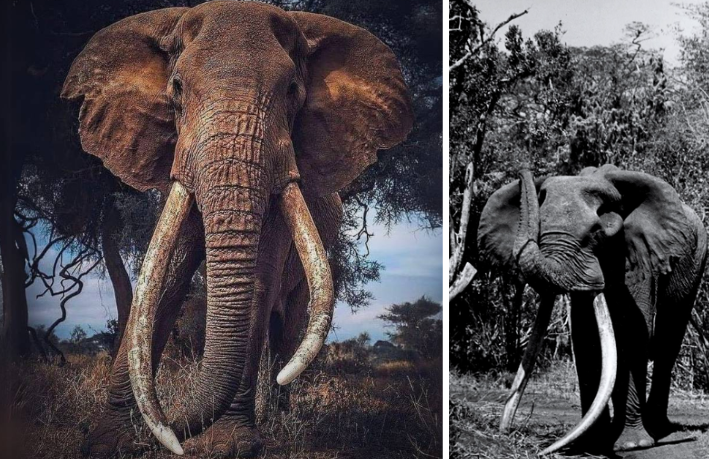Ahmed the Elephant Kenya’s Legendary Tusker

Ahmed the Elephant was a majestic symbol of Kenya’s rich wildlife heritage. Known for his extraordinary size, gentle demeanor, and magnificent tusks. Ahmed has become a legend in the history of wildlife conservation. Revered globally as a testament to the importance of preserving endangered species, Ahmed remains a source of inspiration for conservationists worldwide. This article delves into the fascinating story of Ahmed the Elephant, his life. His contribution to wildlife conservation, and the mystery surrounding his death.
Biography Table of Ahmed the Elephant
| Attribute | Details |
|---|---|
| Name | Ahmed the Elephant |
| Species | African Elephant |
| Born | c. 1919 (Estimated) |
| Age at Death | Approximately 55 years |
| Death Date | 1974 |
| Location | Marsabit National Reserve, Kenya |
| Notable Features | Massive tusks and large size |
| Legacy | Symbol of wildlife conservation |
Ahmed the Elephant: A Brief Introduction
Ahmed the Elephant, often referred to as “Ahmed the Elephant of Marsabit,” lived in the Marsabit National Reserve in northern Kenya. He was an African elephant, widely known for his enormous tusks that almost touched the ground. His unique size and demeanor earned him global attention and a special place in Kenya’s history.
What truly set Ahmed apart was his role in wildlife conservation. During his life, Ahmed became a living symbol of the need to protect. Africa’s dwindling elephant populations from poaching and human encroachment. Ahmed’s story is deeply intertwined with Kenya’s efforts to preserve its rich wildlife heritage. Making him one of the most iconic animals in African history.
The Story of Ahmed the Elephant
Early Life and Habitat
Ahmed was believed to have been born around 1919 in the Marsabit region of Kenya. A vast wilderness area that is home to a diverse range of wildlife. Marsabit National Reserve, where Ahmed spent most of his life, is known for its dense forests, desert landscapes, and unique biodiversity. From an early age, Ahmed’s size and prominent tusks set him apart from other elephants. Drawing attention not only from local communities but also from researchers and poachers.
Ahmed’s peaceful nature and impressive stature became a point of fascination for many. Unlike other elephants, he was rarely aggressive, even in the presence of humans. This gentle demeanor made him a beloved figure in Kenya and a target for photographers, wildlife enthusiasts, and sadly, poachers.

The Threat of Poaching and Government Intervention
During the mid-20th century, poaching reached crisis levels across Africa, with elephants being hunted for their ivory. Ahmed’s massive tusks, which were among the largest ever recorded, made him a prime target for poachers. By the 1960s, conservationists began to voice concerns about Ahmed’s safety.
In 1970, Kenya’s first president, Jomo Kenyatta, declared Ahmed a “national treasure” and took unprecedented steps to ensure his protection. Ahmed became the only elephant in history to be placed under 24-hour government guard. Two armed rangers were assigned to follow Ahmed wherever he went, ensuring his safety from poachers. This extraordinary measure underscored the importance of Ahmed the Elephant to Kenya’s cultural and natural heritage.
Ahmed the Elephant’s Legacy in Wildlife Conservation
Ahmed’s story played a pivotal role in raising awareness about the threats facing African elephants. His iconic status brought global attention to the poaching crisis, inspiring international efforts to combat the illegal ivory trade. Ahmed became a symbol of hope for conservationists and an ambassador for Kenya’s wildlife.
Even after Ahmed’s death, his legacy continues to inspire conservation efforts. The Marsabit National Reserve, where he lived, remains a protected area, and Kenya has implemented stricter anti-poaching laws. Ahmed’s life serves as a reminder of the importance of protecting endangered species and preserving natural habitats for future generations.
Ahmed the Elephant’s Death: Mystery and Legacy
When Did Ahmed the Elephant Die?
Ahmed the Elephant died in 1974, at approximately 55 years of age. His death marked the end of an era, but the details surrounding his passing remain shrouded in mystery. Some reports suggest that Ahmed died of natural causes. While others speculate that his death might have been influenced by human factors.
Ahmed the Elephant Death Date and Circumstances
Although Ahmed’s official death date is recorded as 1974, the exact day and month remain unclear. Wildlife researchers who studied Ahmed noted that his health had been declining due to age. It is widely believed that Ahmed succumbed to old age and the natural challenges of living in the wild. His guarded status ensured that he lived a longer life than most wild elephants, many of whom fall victim to poaching.
After his death, Ahmed’s body was preserved and displayed in the National Museum of Kenya in Nairobi. Where it continues to educate visitors about the importance of wildlife conservation.
The Impact of Ahmed the Elephant on Kenya
Ahmed the Elephant holds a special place in Kenya’s history. As a national treasure, he represented the country’s commitment to protecting its wildlife and natural resources. The story of Ahmed the Elephant of Marsabit has been told and retold as a powerful reminder of the need to balance human development with environmental conservation.
Ahmed’s protected status set a precedent for how governments and conservation organizations could work together to safeguard endangered species. His legacy lives on in the form of conservation programs, anti-poaching initiatives, and the enduring beauty of Kenya’s national parks and reserves.
Lessons from Ahmed the Elephant’s Story
Ahmed the Elephant story offers valuable lessons about the importance of conservation. His life reminds us that the natural world is both fragile and irreplaceable. As human populations grow and demand for resources increases, the pressure on wildlife and natural habitats continues to mount. Ahmed’s journey underscores the need for collective action to protect endangered species and ensure the survival of ecosystems.
Ahmed the Elephant’s Unique Place in History
Ahmed the Elephant was not just an animal; he was a symbol of hope, resilience, and the enduring beauty of nature. His massive tusks and gentle personality made him a global icon, but his true significance lies in the role he played in shaping conservation efforts in Kenya and beyond.
Today, Ahmed’s story is told in schools, museums, and wildlife documentaries, inspiring a new generation to value and protect the natural world. His legacy reminds us that every species, no matter how big or small, has a role to play in the intricate web of life on Earth.
Conclusion
Ahmed the Elephant remains an enduring symbol of Kenya’s commitment to wildlife conservation. His story, from his early days in the Marsabit National Reserve to his protected status and eventual death, highlights the challenges and triumphs of protecting endangered species. While Ahmed’s life came to an end in 1974, his legacy lives on as a testament to the power of conservation efforts and the importance of preserving our planet’s natural heritage.
By reflecting on the life of Ahmed the Elephant, we are reminded of the vital role each of us can play in protecting wildlife. Whether through supporting conservation programs, advocating for stricter anti-poaching laws, or simply raising awareness, we can all contribute to a world where magnificent creatures like Ahmed can thrive for generations to come.



